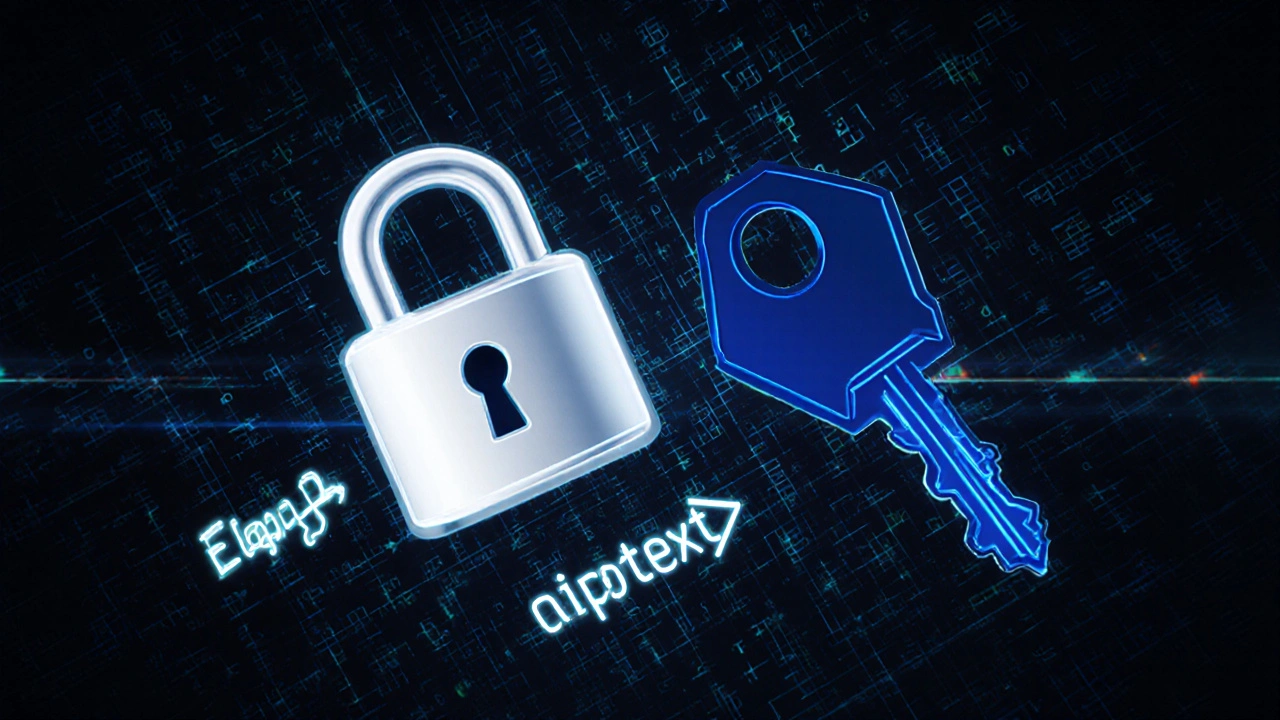Imagine sending a secret note that only the right person can open - even if a nosy neighbor reads the whole page. That’s the magic behind asymmetric encryption, the backbone of modern crypto.
Quick Takeaways
- Asymmetric encryption uses a pair of mathematically linked keys - one public, one private.
- It enables secure communication, digital signatures, and safe key exchange without sharing secret keys beforehand.
- Common algorithms include RSA (based on factorising large numbers) and ECC (based on elliptic‑curve maths).
- Unlike symmetric encryption, it is slower but provides authentication and non‑repudiation.
- Implementation best practices: use trusted libraries, keep private keys safe, and combine with symmetric encryption for performance.
Below we break down the core ideas, walk through how the math works, and give you a cheat‑sheet for picking the right tool.
What Is Asymmetric Encryption?
Asymmetric encryption is a cryptographic method that uses two different but mathematically linked keys - a public key for encryption and a private key for decryption. It belongs to the broader family of public key cryptography, which was first described by Whitfield Diffie and Martin Hellman in 1976.
The public key can be shared with anyone. The private key stays secret with its owner. Data encrypted with the public key can only be decrypted with the matching private key, and vice‑versa for digital signatures.
How the Two‑Key System Works
Think of the keys as a lock and its unique key. The lock (public key) is posted on a mailbox; anyone can drop a letter in, but only the holder of the matching key (private key) can open the box and read the contents.
- Key Generation: A cryptographic algorithm creates a key pair. The math ensures that deriving the private key from the public key is computationally infeasible.
- Encryption: Sender obtains the recipient’s public key, encrypts the plaintext, and sends the ciphertext.
- Decryption: Recipient uses their private key to transform the ciphertext back into the original message.
- Signing: To prove authorship, the sender hashes the message and encrypts the hash with their private key. Anyone can verify the signature with the sender’s public key.
Because the private key never leaves the owner's device, the system eliminates the need for a pre‑shared secret, a major advantage over symmetric schemes.
Key Players: Core Entities in Asymmetric Crypto
- Public key: Distributed openly; used to encrypt data or verify signatures.
- Private key: Kept secret; used to decrypt data or create signatures.
- RSA algorithm: Relies on the difficulty of factoring large integers; keys typically 2048‑bit or larger.
- Elliptic‑Curve Cryptography (ECC): Uses the algebraic structure of elliptic curves; offers comparable security with shorter keys (e.g., 256‑bit ECC ≈ 3072‑bit RSA).
- Digital signature: A cryptographic proof that a specific private key signed a message.
- Symmetric encryption: Uses a single secret key for both encryption and decryption; faster but requires a safe channel to share the key.
- Public Key Infrastructure (PKI): A framework of certificates, certificate authorities, and registration authorities that validates public keys.

Common Algorithms and When to Use Them
RSA has been the workhorse for decades. Its straightforward mathematics make it widely supported in browsers, email clients, and VPNs. However, as computing power grows, RSA keys need to be longer to stay safe, which slows down operations.
ECC gained traction in the 2010s because it delivers the same security level with much smaller keys. Mobile devices, IoT gadgets, and modern browsers favour ECC (e.g., the secp256r1 curve) for its low power consumption.
Other niche algorithms include ElGamal (useful for homomorphic properties) and DSA (focused on digital signatures). Most developers just need RSA or ECC, and the choice often hinges on platform support.
Real‑World Use Cases
- Secure Email (PGP/GPG): Users exchange public keys, encrypt messages, and sign them to guarantee authenticity.
- HTTPS/TLS: A web server presents an X.509 certificate (public key) during the TLS handshake. The browser validates it via PKI, then both sides negotiate a symmetric session key.
- Cryptocurrency Wallets: Each wallet address derives from a public key; transaction signatures prove ownership without exposing the private key.
- Code Signing: Developers sign binaries so users can verify that the software hasn’t been tampered with.
- Key Exchange (Diffie‑Hellman, ECDH): Parties generate a shared secret over an insecure channel, later used as a symmetric key.
Asymmetric vs. Symmetric Encryption: A Quick Comparison
| Aspect | Asymmetric (Public‑Key) | Symmetric (Secret‑Key) |
|---|---|---|
| Key Count | Two (public & private) | One |
| Speed | Slower - heavy calculations | Fast - simple operations |
| Key Distribution | No secure channel needed for public key | Requires a secure channel to share the secret key |
| Typical Use | Handshake, digital signatures, key exchange | Bulk data encryption after a secure session is established |
| Key Size (security equivalence) | 2048‑bit RSA ≈ 256‑bit ECC | 128‑bit AES considered strong today |
| Scalability | Every participant needs its own key pair | One shared key per communication channel |
Security Considerations and Common Pitfalls
Even the strongest algorithm can crumble if you mishandle keys.
- Private Key Leakage: Store private keys in hardware security modules (HSMs) or encrypted files with strong passphrases.
- Weak Random Number Generators: Key generation depends on high‑quality entropy. Old or embedded devices may need an external RNG.
- Outdated Algorithms: RSA‑1024 and older ECC curves are considered weak. Aim for RSA‑2048 or higher and curves like
secp256r1orCurve25519. - Certificate Trust Chains: In PKI, an untrusted certificate authority can enable man‑in‑the‑middle attacks. Verify the chain up to a root that your platform trusts.
- Side‑Channel Attacks: Timing or power analysis can reveal private key bits on poorly designed hardware. Use constant‑time implementations.

Practical Implementation Guide
Most developers won’t build the math from scratch; they’ll rely on vetted libraries.
- Choose a Library: For Python,
cryptographyorPyCryptoDome. In JavaScript, the Web Crypto API is built‑in. - Generate a Key Pair:
# Python example using cryptography from cryptography.hazmat.primitives.asymmetric import rsa from cryptography.hazmat.primitives import serialization private_key = rsa.generate_private_key(public_exponent=65537, key_size=2048) public_key = private_key.public_key() # Export PEM‑encoded keys pem_private = private_key.private_bytes( encoding=serialization.Encoding.PEM, format=serialization.PrivateFormat.PKCS8, encryption_algorithm=serialization.BestAvailableEncryption(b"my‑strong‑pass") ) pem_public = public_key.public_bytes( encoding=serialization.Encoding.PEM, format=serialization.PublicFormat.SubjectPublicKeyInfo ) - Encrypt Data (recipient’s public key):
from cryptography.hazmat.primitives import hashes from cryptography.hazmat.primitives.asymmetric import padding ciphertext = public_key.encrypt( b"Secret message", padding.OAEP(mgf=padding.MGF1(algorithm=hashes.SHA256()), algorithm=hashes.SHA256(), label=None) ) - Decrypt Data (own private key):
plaintext = private_key.decrypt( ciphertext, padding.OAEP(mgf=padding.MGF1(algorithm=hashes.SHA256()), algorithm=hashes.SHA256(), label=None) ) - Sign & Verify:
# Signing signature = private_key.sign( b"Message to sign", padding.PSS(mgf=padding.MGF1(hashes.SHA256()), salt_length=padding.PSS.MAX_LENGTH), hashes.SHA256() ) # Verification public_key.verify( signature, b"Message to sign", padding.PSS(mgf=padding.MGF1(hashes.SHA256()), salt_length=padding.PSS.MAX_LENGTH), hashes.SHA256() )
Always pair asymmetric encryption with a symmetric algorithm (like AES‑256) for the actual payload. The asymmetric step only secures the symmetric session key.
Future Trends
Quantum computers threaten RSA and ECC because Shor’s algorithm can factor large numbers and solve discrete logarithms. Post‑quantum candidates like lattice‑based cryptography (e.g., Kyber) and hash‑based signatures (e.g., XMSS) are being standardized by NIST. Keep an eye on the timeline - most experts say practical quantum attacks are at least a decade away, but early adopters are already testing hybrid schemes.
Frequently Asked Questions
How does asymmetric encryption differ from symmetric encryption?
Asymmetric encryption uses a public and a private key pair, so you never need to share a secret beforehand. Symmetric encryption relies on a single shared secret, which must be exchanged over a secure channel. As a result, asymmetric methods are slower but provide authentication and non‑repudiation, while symmetric methods are faster for bulk data.
Is RSA still safe to use in 2025?
Yes, provided you use key lengths of at least 2048 bits. For high‑security environments, 3072‑bit or 4096‑bit keys are recommended. Shorter keys (e.g., 1024‑bit) are considered vulnerable to modern factoring attacks.
What is the advantage of ECC over RSA?
ECC offers comparable security with much smaller key sizes, which means faster computations and lower memory usage - ideal for mobile devices and IoT hardware.
Can I use asymmetric encryption to encrypt large files?
Not directly. Encrypt the file with a symmetric algorithm like AES‑256, then encrypt the AES key with the recipient’s public key. The recipient decrypts the AES key with their private key and finally unlocks the file.
What is a digital signature and how does it work?
A digital signature is created by hashing a message and then encrypting the hash with the sender’s private key. Anyone can verify the signature by decrypting it with the sender’s public key and comparing the result to a newly calculated hash of the message.
Do I need a full PKI to use asymmetric encryption?
No. For ad‑hoc communication you can exchange raw public keys manually or via trusted out‑of‑band channels. PKI becomes essential when you need scalable trust, revocation, and automated verification, as in HTTPS.
Next Steps
If you’re just starting, pick a language‑specific library, generate a RSA‑2048 key pair, and try encrypt‑then‑decrypt a short message. Once comfortable, experiment with ECC and integrate a hybrid scheme (asymmetric key exchange + AES‑256 payload) in a small client‑server prototype.
Keep your private keys safe, stay up‑to‑date with recommended key sizes, and monitor NIST’s post‑quantum roadmap. With those habits, asymmetric encryption will remain a reliable shield for your crypto needs.


